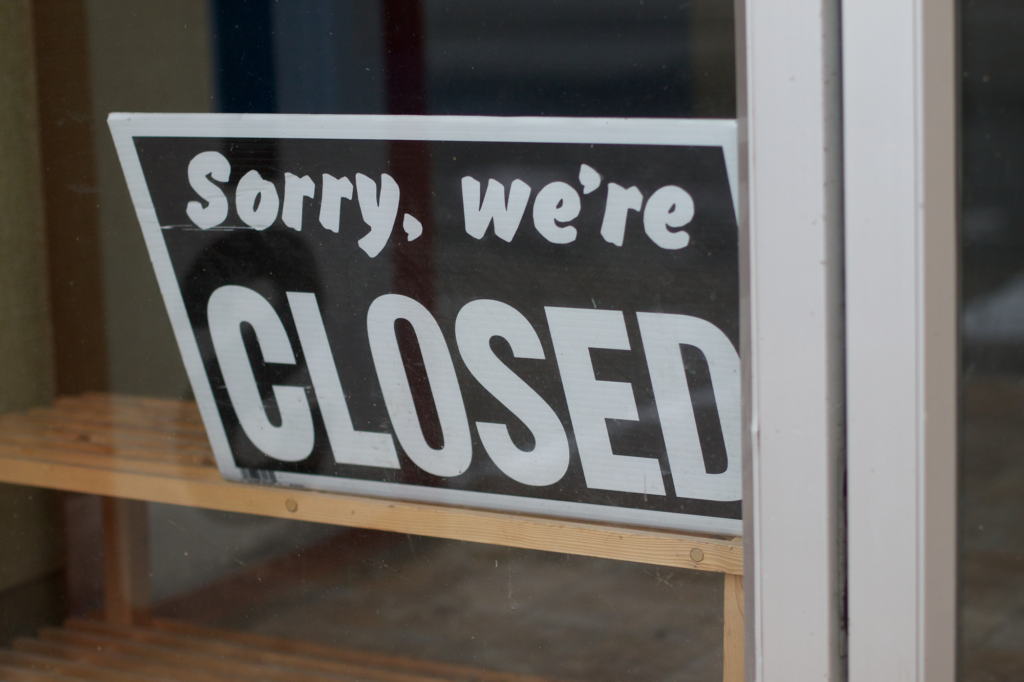
Recent figures show a decline in part-time work in Northern Ireland (NI) since the advent of the COVID-19 pandemic.[1] This article describes recent job losses and investigates their impact on employment among women in NI.
Pandemic job losses
The COVID-19 pandemic and ensuing economic shock has led to job losses across the United Kingdom (UK). The Northern Ireland Statistics and Research Agency (NISRA) reported that the number of employee jobs in NI decreased by 1.2% (equivalent to a loss of more than 9,000 jobs) from March 2020 to March 2021. NISRA’s latest figures show NI’s unemployment rate stands at 3.6%; the second lowest rate among the twelve UK regions. In NI, pandemic job losses were driven by a decline in part-time jobs as illustrated in Figure 1 below:
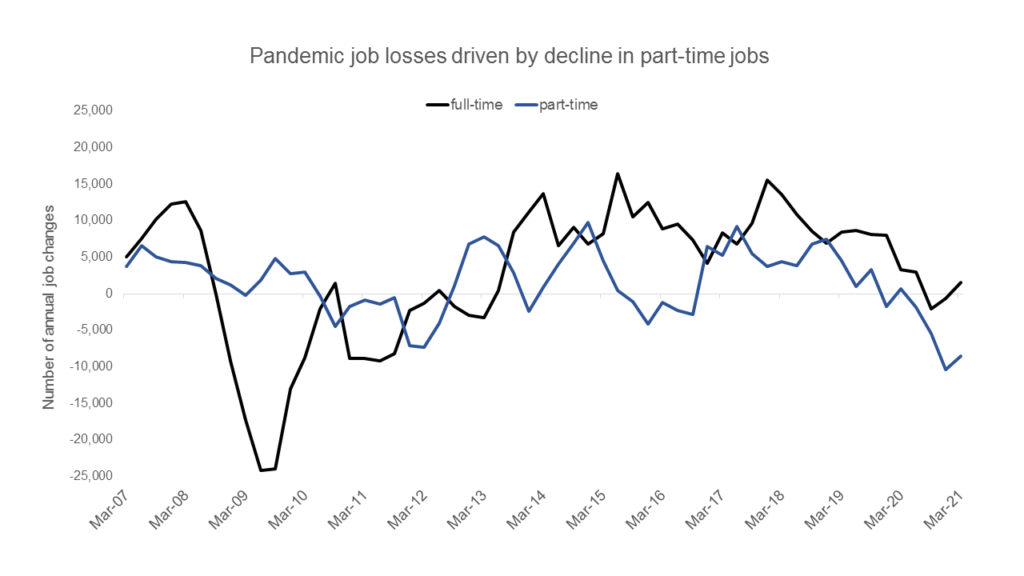
While the number of full-time jobs increased in NI by 0.3% over the year to March 2021, NISRA reported that the number of part-time jobs decreased by 3.2%. It further noted that the proportion of part-time jobs was 34% of all employee jobs recorded in March 2021; the lowest it has been since September 2007. The impact of the COVID-19 pandemic stands in stark contrast to the effects of the 2008 recession, when job losses were driven by a decline in the number of full-time, rather than part-time jobs, as Figure 1 above highlights.
Part-time work and gender income inequality in NI
Changes in part-time work patterns have the potential to cause significant changes to women’s employment levels in NI, which is illustrated by looking at the NI gender pay gap. Uniquely among UK nations, women in NI earned as much, or even slightly more than men in the year to December 2020, when reviewing wages for full-time and part-time work individually. However, a much smaller proportion of NI women than men worked full-time during the stated period: 57% of women compared to 84% of men. Hence, a much larger proportion of pay women receive in NI is earned through part-time work, which typically is lower paid[2] than full-time work. Figure 2 below seeks to highlight NISRA’s findings in this area:
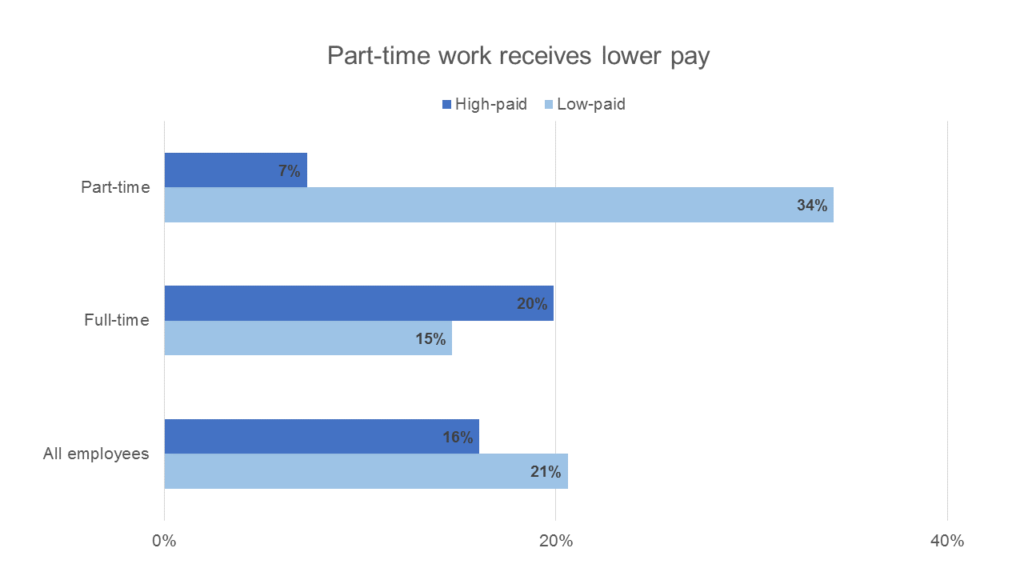
As a result, during the stated period, NISRA calculates the median pay for women in NI, irrespective of working-pattern, to be £11.29. That compares to median pay for NI men at £12.30.
Given the prevalence of part-time work among women in NI, the recent decline in part-time jobs could be expected to disproportionately impact women. Counterintuitively, if disproportionately more women lost part-time employment as a result of the pandemic, this may not widen the gender pay gap in NI. Rather, the development could actually narrow the gender pay gap because a lower proportion of women’s pay would derive from low-paid part-time work. Nevertheless, the income of those women in part-time employment who lost it during the pandemic would most likely be negatively affected, placing them at greater risk of poverty. Consequently, the rest of this article highlights available data on job losses, benefit claims and economic activity rates to consider the extent to which pandemic job losses have impacted employment amongst women in NI.
Effects of pandemic job losses on women in NI
The currently available data does not show that part-time job losses have affected women in NI more so than men. Of note are recent experimental claimant count figures, which represent those who claim Jobseekers Allowance, or who receive Universal Credit as a result of seeking work.[3] The seasonally adjusted claimant count rate for those claiming either benefit[4] increased from 3.1% to 5.8% between March 2020 and April 2021 in NI. Looking at men’s and women’s claim rates separately, men’s claimant rates increased by 3.3 percentage points (pp), compared to 2.1 pp in women. Those findings seem to suggest that losses in the number of part-time jobs in NI have not translated into higher claimant rates amongst women.
Economic inactivity rates in NI (measuring the proportion of those aged 16-64 that are neither in work nor actively looking for work) show a similar picture. The overall inactivity rate increased from 26.2%, to 28.3%, in the year to Q1 2021. However, the men’s inactivity rate increased by 3.5pp; whereas the women’s rate increased much less drastically, by 0.7pp. It should be noted, however, that women’s economic inactivity rate, at 31.4%, is still higher than that of men. Figure 3 below seeks to show the noted gender disparity and its development over the course of the pandemic:
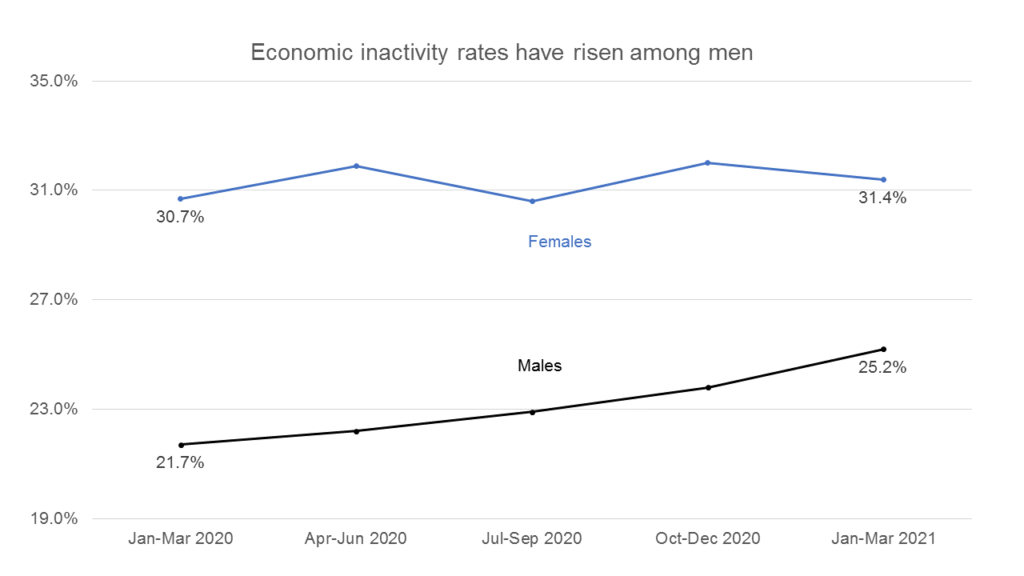
Figure 3: Economic inactivity in NI over last five quarters (Source: NISRA. Labour Market Report – May 2021)
Both the benefit claimant and the economic inactivity rates are surprising as those sectors that have seen the most job losses, are also those in which women are disproportionally represented, such as in the services sector, which has shrunk by 1.6% in the year to December 2020. Conversely, the construction sector, in which men are disproportionately represented, grew by 3.3% during the same period, as is shown in Figure 4 below:
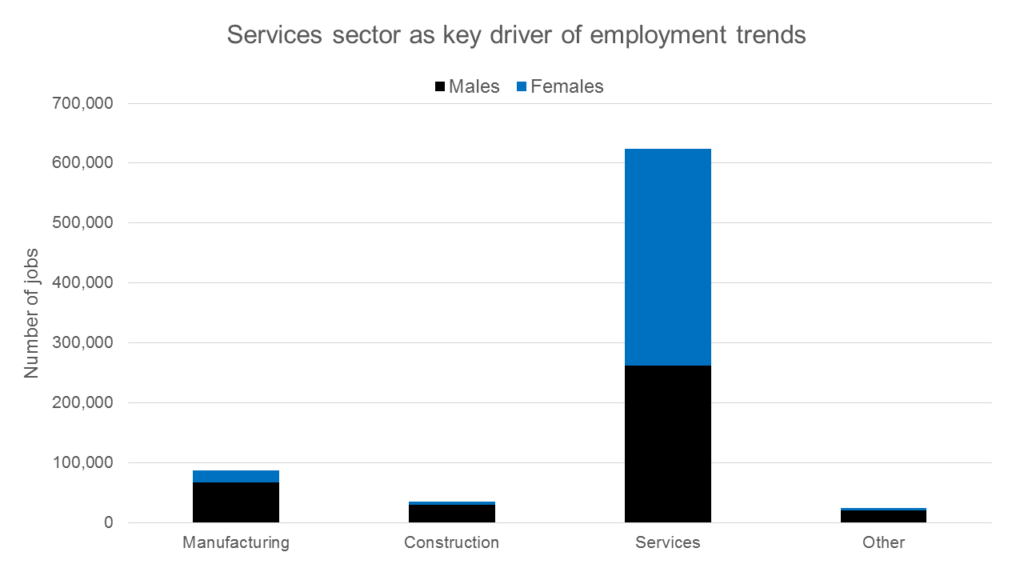
One thing to keep in mind when considering sectoral gender disparities is the reality that the services sector as a whole is much larger than other sectors in NI. Even though the vast majority of jobs within the construction sector are held by men, they are vastly outnumbered by jobs in the services sector. Nevertheless, 58% of the sector comprises women as opposed to 42% consisting of men. That means that changes to the services sector would invariably be expected to impact women in NI to a greater extent. However, the data discussed above does not appear to show the anticipated effect.
Part-time job losses in NI among men
A closer look at which kinds of jobs have been lost can provide a better understanding of why employment levels amongst women have not been affected in this manner. A recent NISRA Quarterly Employment Survey provides some additional data on the number of jobs lost in NI, as well as some additional information on who lost them, as illustrated below in Figure 5.
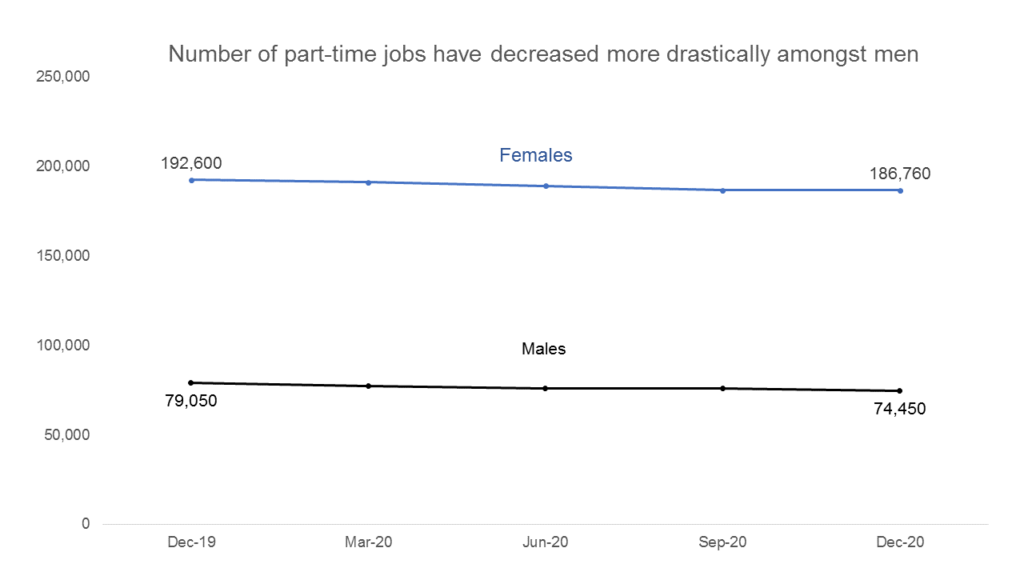
Looking at the trend of part-time job losses in NI, men accounted for 4,600 job losses; while women lost 5,840 in the year to March 2021. However, considering women held 71% of part-time jobs in March 2020, the noted job losses represent a 6% decrease for part-time jobs held by men and ‘only’ a 3% decrease in part-time jobs held by women. The data also shows that there were rises in full-time employment, particularly among men for that period. However, it is important to note here that a rise in employment does not need to correspond to a fall in unemployment, as people can become economically inactive without including them in the unemployment count. In any case, as the increases in full-time work are relatively small during the given period, those gains could not make up for the decline in part-time jobs, which has resulted in increased claimant and economic inactivity rates amongst men in NI.
Due to the relatively small population in NI, and consequently the small labour force, when compared to other UK regions quarterly changes can look quite extreme in percentage terms. In particular, there have been fluctuations in job losses that have affected men and women differently throughout the pandemic. For example, inactivity rates rose more quickly for women in the first six months of the pandemic, but later decreased; whereas they rose by 2.4pp alone among men during the fourth quarter of 2020. Due to the lag in the collection and publication of economic data, the full effects of the pandemic on the labour market, and on job losses in particular, remains to be seen.
Going forward, one particular development to look out for is the impact during summer 2021 of the tapering off of the UK Government’s Furlough Scheme: What will happen to employment figures in NI? Throughout the UK, the number of jobs held by women who have been furloughed outnumber those held by men, according to figures provided by HM Revenue & Customs. In January 2021, 54,300 women in NI were furloughed, as compared to 51,900 men. This is despite the fact that men make up a larger percentage of employees in NI. As a result, women might be particularly vulnerable to losing their jobs, as employers are asked by the Government to contribute more to the Furlough Scheme, from July 2021, until the scheme ends, which currently is scheduled for September 2021.
—–
[1] For the purposes of this article, ‘part time work’ is defined as work undertaken for less than 30 hours a week. See A guide to labour market statistics for an overview of different definitions used.
[2] For these purposes, low pay is defined as any value below two thirds of the UK median hourly earnings.
[3] It is possible that a rise in unemployment among women is not reflected accurately in these figures as women may be more likely to be receiving benefits without being required to look for work as a result of childcare responsibilities. This article therefore also considers rates of economic inactivity in the next paragraph.
[4] In fact, there is actually a small amount of double-counting as it is, under some very limited circumstances possible to claim both benefits. However, the ONS suggests that this should affect at most 1.5% of claimants counted. See https://www.ons.gov.uk/employmentandlabourmarket/peoplenotinwork/outofworkbenefits/datasets/claimantcountcla01 for more information.

